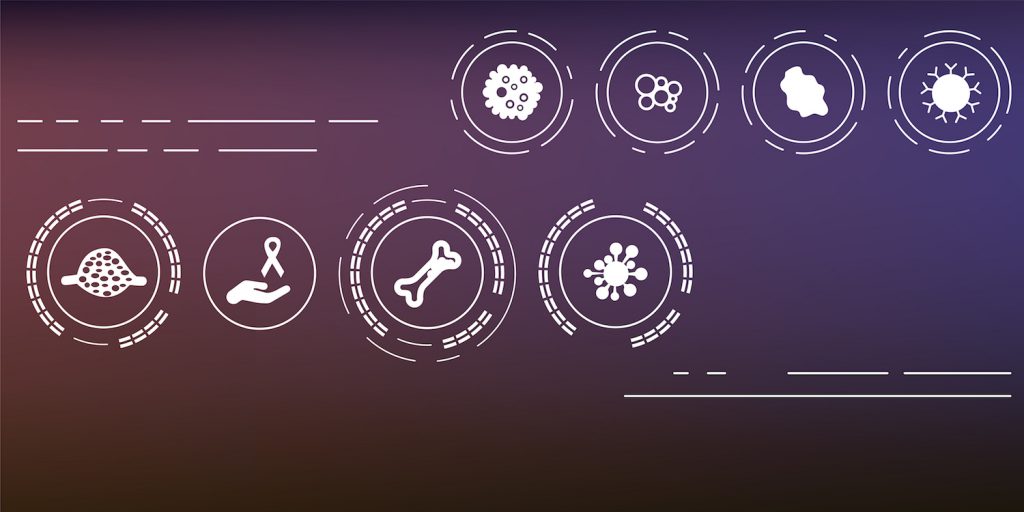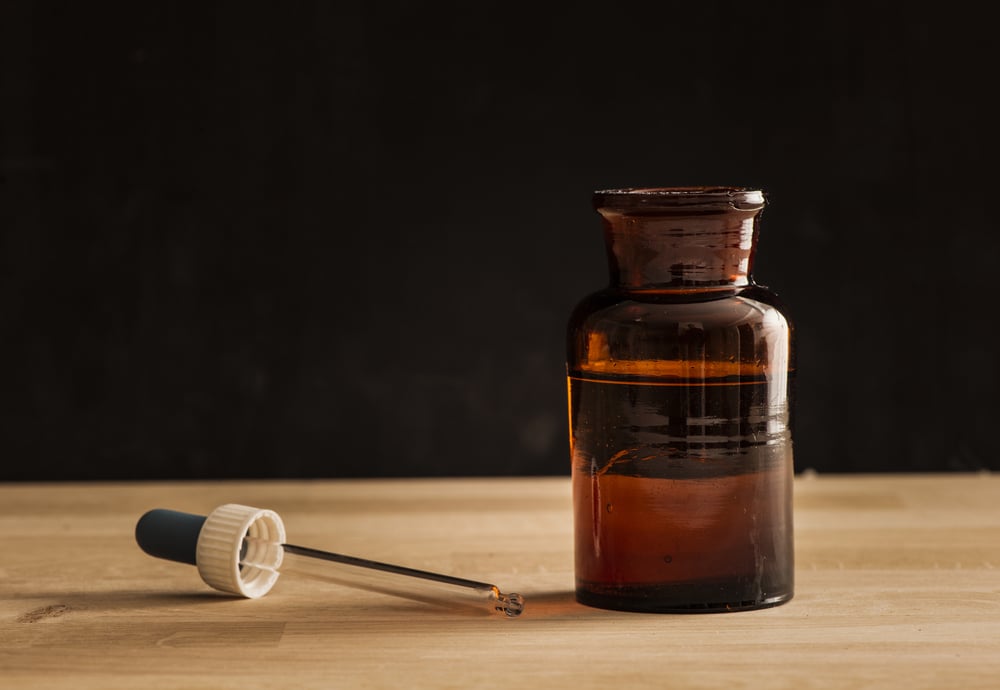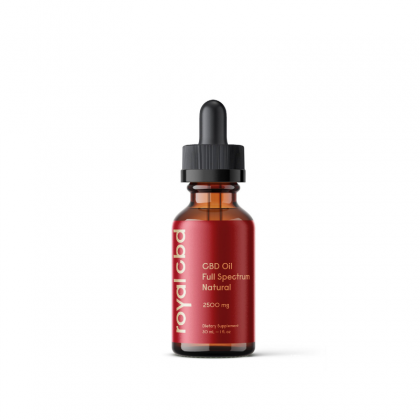| Total CBD: | 500 – 2500 mg |
| Potency: | 16.6 - 83.3 mg/mL |
| Cost per mg CBD: | $0.12 – $0.18 |
| Extract Type: | Full-spectrum |
| THC Content: | <0.3% |

Evidence based
Can CBD Oil Help with Cancer and Chemotherapy Side-effects?
Studies have shown that CBD oil can help relieve nausea and pain in cancer patients.
So how does it work and how is it taken?
Can CBD really help with cancer?
There are currently two cannabis-based pharmaceutical medicines approved for in cancer patients in the United States — Dronabinol (Marinol®) and Nabilone (Cesamet®).
A third drug — Sativex (Nabiximil®) — is approved throughout the United States, Europe, Canada, Australia, and New Zealand.
Each of these medications is based on the naturally produced cannabinoids made by the cannabis plant — such as THC (tetrahydrocannabinol) and CBD (cannabidiol).
Can CBD provide benefits to patients with cancer?
In this article, we’ll review the scientific literature on how CBD is being used with cancer patients, and what the current research suggests about its mechanism of action.
What Are the Benefits of CBD Oil for Cancer?
CBD and other cannabinoids found in the hemp plant have been the focus of a lot of research in terms of cancer therapy and palliative support.
Although there is still a lot of research needed to prove the effects of CBD as discussed in this article, the current findings are promising.
The key benefits of CBD for cancer include:
- CBD regulates key immune cells tasked with detecting & eliminating cancer cells from the body
- CBD may alleviate cancer-related pain
- CBD supports sleep duration and quality
- Cannabinoids related to CBD may boost hunger levels
- CBD may slow tumor growth
- CBD alleviates nausea & vomiting associated with chemotherapy
- CBD may support anxiety & depression associated with a cancer diagnosis
1. CBD Regulates Key Immune Cells Tasked With Detecting & Eliminating Cancer Cells From the Body
Most people have had cancer cells in their bodies at one point or another.
Normally, the immune system is able to identify the cancerous cells early and dispose of them. Specialized immune cells are tasked with performing this important job of detecting, and eliminating abnormal cells such as cancer. The most important of these immune cells are the T-Cells (T-lymphocytes) and NK cells (natural killer cells) [15, 16].
Sometimes the immune system is tricked by cancer to believe it’s not a threat — allowing it to grow out of control in the body [21].
Scientists believe CBD may provide anti-cancer benefits through its interaction with the CB2 endocannabinoid receptors — which have been shown to be present on T-lymphocytes, B-lymphocytes, and Natural Killer (NK) cells [14] but are most abundant on B-cells and NK cells [22].
This interaction is highly complex and researchers are still seeking to understand how CBD and other cannabinoids affect the immune system’s ability to detect and eliminate cancerous cells throughout the body. However, the current understanding, as highlighted by a Polish review paper published in 2017, is that CBD supports a shift in immune activation from being TH2 dominant (commonly found in cancer patients) to TH1 dominant (believed to resist cancer growth) [5, 24].
If you’re not sure what TH1 and TH2 immune responses are, don’t worry — it’s extremely complicated, and medical researchers who have dedicated their entire lives to the study of immune function still have a lot of unanswered questions about this particular interaction.
In basic terms, the immune system has two main sides — TH1, and TH2 — each one optimized for a different job:
- TH1 is better for attacking and removing invading pathogens but is also a perpetuating factor for autoimmune disease.
- TH2 is more involved in maintaining inflammatory reactions and allergies.
Unfortunately, this system can become disoriented during cancer, and TH1/TH2 can either make cancer better or worse [32].
Sometimes this system needs a push in the right direction to make sure the right part of the tool is being used for the job.
2. CBD May Alleviate Cancer-Related Pain
One of the main side effects of cancer is pain — which can be debilitating.
Pain is often caused by the tumor pressing on nerves, bones, and organs in the body. Chemotherapy medications also cause pain as a side effect, with tingling and numbness often experienced in the fingers and toes [25].
This makes pain management one of the main goals for doctors treating those with cancer.
CBD is an excellent option for managing the pain experienced by cancer patients because it works through more than one mechanism to achieve this effect.
CBD is thought to work through activation of the vanilloid pain receptors [17] — which are known to play a pivotal role in blocking the transmission of pain to the spinal cord and brain [18].
In a recent study, an extract containing both CBD and THC was shown to relieve pain in patients with advanced cancer where opioids were ineffective [7].
3. CBD Supports Sleep
Chronic pain associated with cancer, along with other side effects like anxiety and depression can make it difficult for patients to fall asleep and stay asleep.
CBD may help by reducing symptoms like pain and anxiety that can interfere with sleep.
A recent review article highlighting the years of phase I, II, and III clinical trials conducted with the cannabinoid-based pharmaceutical preparation, Sativex, showed significant improvements in sleep quality and duration among cancer patients as well as other chronic and life-threatening health conditions [8].
This review included information gathered from 2000 different patients and roughly 1000 patient years of exposure to the medication.

4. Related Cannabinoids May Boost Hunger Levels
One of the main side effects of cancer treatment is a reduced appetite.
A healthy appetite is vitally important to supply the body with the nutrients it needs to promote recovery.
If we’re not eating enough, it makes it even more difficult for the body to fight cancer, so ensuring we eat enough food is of the utmost importance.
CBD isn’t known for its ability to increase appetite. This effect is mainly attributed to the THC content of marijuana instead. A phase II clinical trial published in 1994 showed that 13 out of 19 cancer patients experiencing severe weight loss and appetite suppression had significantly increased appetite and weight gain after taking THC [20].
Although not legal in many states, THC has actually been shown to offer significant improvements in appetite [13]. So if you can get access to CBD oil with THC, this is likely to offer the most benefit on this effect.
5. CBD May Slow Tumour Growth
The main goal of cancer treatment is to stop tumors from growing and to give the body the best chance of fighting back.
CBD oil has been shown to inhibit tumor cell growth and helps to stop it from spreading to other areas of the body.
In some patients, the use of CBD has led to decreased tumor cell growth rate and invasion [5]. Most of the research in this domain involves animal studies and are in need of long-term clinical trials involving humans to be confirmed.
However, there has been plenty of research showing a reduction in tumors through animal and in vitro research — such as this on pancreatic cancer [23], brain cancer [26], and colon cancer [27], to name a few.
There are a few suggested theories as to how CBD is able to reduce tumor size in cancerous tumors — such as through anti-inflammatory, antioxidant, and immunomodulatory effects, as well as induced-apoptosis (programmed cell death) — however, this depends highly on the form of cancer being treated along with a host of other factors.
6. CBD Alleviates Nausea & Vomiting
Nausea and vomiting are both common side effects of chemotherapy. Treating these symptoms will offer a significant improvement in cancer patients’ overall quality of life.
Cannabis has been used for centuries to relieve both nausea and vomiting. There is both anecdotal and research-based evidence supporting the use of CBD for therapeutic improvement in chemotherapy-induced nausea and vomiting [9].
The largest of these studies was a Cochrane review that analyzed the results of 23 clinical trials involving cannabinoids — which concluded that cannabinoids were highly effective and providing similar results to conventional treatments for alleviating chemotherapy-induced nausea and vomiting [28].
It’s worth noting that some studies found the opposite effect [7]. So it’s worth giving CBD a try before relying on it to alleviate nausea and vomiting. This can be very different from one person to the next.
7. CBD May Support Anxiety & Depression Associated With a Cancer Diagnosis
A cancer diagnosis can be extremely stressful, and many people suffer from depression and anxiety during and after treatment (anywhere from 0%–58% depending on the study and stage/type of cancer) [29].
Reducing anxiety and depression are considered one of the most important treatment steps for supporting cancer recovery and improving the quality of life of those affected.
CBD has well-known benefits for reducing symptoms of depression and anxiety — which has been studied thoroughly through animal testing [30]. Several clinical trials are currently underway to investigate the specific effect of using CBD on humans suffering from various forms of depression.
More research is needed to prove these effects in humans.
When this is combined with lifestyle changes, supportive friends and family, and a lot of personal contemplation, it can be an extremely powerful tool in alleviating depression, anxiety, and overall health and wellbeing.

What is Cancer?
The World Health Organization (WHO) states that cancer is the second leading cause of death globally. In 2018, cancer is estimated to contribute to 9.6 million deaths worldwide [1].
So what exactly is cancer? Where does it come from?
Our cells are constantly multiplying themselves to replace those that are lost through damage and natural cell death. When cells are lost, new ones are formed to replace them.
However, sometimes this process breaks down and the body produces abnormal cells instead of healthy ones. Occasionally these abnormal cells become cancerous and will begin to self-replicate and spread.
What went wrong? What causes the formation of these abnormal and potentially cancerous cells?
It all starts with our DNA.
Our DNA is responsible for providing the blueprints to manufacture a new cell. The body references these blueprints every time a new cell is made. If the DNA becomes damaged, it can cause issues with the replication process — producing abnormal, or dysfunctional cells instead of healthy ones.
These dysfunctional cells can either be cancerous, or non-cancerous — however, both may start replicating themselves to produce more abnormal cells — eventually forming large “colonies” of abnormal cells known as tumors.
Non-cancerous (benign) tumors remain confined to the affected organ and their growth is generally slow. They eventually become cut off from the rest of the body as healthy cells begin to grow around the tumor in order to keep the organ functioning properly. These tumors are rarely fatal if caught early. They only become dangerous when the tumor grows so large it begins pressing on other organs — impeding their function.
Cancerous (malignant) tumors are very different. Instead of forming tumors that are cut off from the rest of the body, they integrate themselves into new areas — spreading the dysfunctional cell types to other organs and tissues. This is referred to as “metastasis”.
Cancer cells have a certain “intelligence” to them — replicating themselves relentlessly, even forming their own blood vessels to feed the energy-intensive growth of the tumor. Some cancers will even take measures to resist the effects of chemotherapy medications designed to kill them.
Cancer Cells Can Resist Chemotherapy a Few Different Ways:
- By pumping the chemotherapy agent out of the cancerous cells
- By blocking the protein on the cancer cell wall that lets the chemotherapy agent in
- By deactivating the chemotherapy agent before it can take effect
- By quickly repairing the damage caused by the chemotherapeutic agent
This type of cell dysfunction can be very dangerous — resisting attacks from the immune system, and spreading to new areas of the body.
Cancer is Not a Single Disease
According to the National Cancer Institute, there are more than 100 different types of cancer. Each type is characterized by the organ cancer first originated in. For example, lung cancer originates in the lungs, while skin cancer starts in the skin.
Cancer can also be characterized by the type of cell that forms the tumor.
Each type of cancer is unique and may require different treatments but the general concept is the same — to stop the spread of cancer cells by interrupting their ability to replicate themselves. This is the primary goal of chemotherapy medications.

What is CBD?
Cannabidiol (CBD) is just one out of the 400 compounds found in the cannabis plant. There are two primary therapeutic compounds contained within the leaves and flowers of the plant — THC, and CBD. These compounds are closely related but have some key differences in their effects.
1. THC is the primary psychoactive component of cannabis and although it has beneficial pain-relieving and anti-inflammatory effects, it can also cause some unwanted side effects such as cognitive impairment, anxiety, sedation, dizziness, dry mouth, and/or eyes, psychosis, and poor motor coordination.
Pharmaceuticals like Dronabinol and Nabilone are synthetic versions of THC used as adjunctive treatments for cancer patients.
2. CBD is the primary non-psychoactive component of cannabis and has been shown to have neuroprotective, anti-inflammatory, anxiolytic, and antipsychotic therapeutic actions without the typical mind-altering side effects of THC (more on this below).
Recent studies have shown that CBD exhibits anticancer activity in many types of cancer such as colorectal (colon), breast, lung, prostate, glioblastoma, melanoma, leukemia, and neuroblastoma [5].

How Are Cancer Patients Using CBD?
This article is intended for informational use only — always speak with your doctor before using CBD or any other supplement.
There are a lot of people these days using supplements like CBD to support their immune system, and address some of the most common side-effects of cancer and chemotherapy.
Side effects patients may experience range from weight loss, fatigue, peripheral neuropathy, mouth ulcers, blisters, and hair loss.
Widespread research has shown CBD to have a high level of safety — even in combination with other pharmaceutical medications [31]. However, CBD does interact with some medications.
The most common method of taking CBD oil is oral. This allows an easily administered form of the supplement, allows users to measure dosages accurately, and has a relatively high absorption rate compared to other methods.
CBD can also be taken in capsule form, used topically (such as with skin cancer), disguised in beverages, or baked into food.
Most of the research on using CBD and other cannabinoids with other cancer therapies involved higher doses than other health conditions. Speak with your doctor about the right dose, and remain consistent with the dosage regimen for best results.

Key Takeaways: Using CBD With Cancer
Research involving CBD has shown a lot of promise as an adjunctive treatment with cancer patients — however, more research is needed to prove these effects in practice.
The majority of the research on this application involves in vitro research animal testing, and small group human research trials.
The benefit of this useful health supplement lies in its ability to interact with the endocannabinoid system — which is deeply connected with the inflammatory response, and other aspects of the immune system including the balance between TH1 and TH2 responses.
CBD may also provide benefits to some of the common side-effects of chemotherapy and cancer such as nausea, vomiting, pain, insomnia, anxiety, and depression.
With its long list of therapeutic benefits and a widespread lack of substantial risk or side effects, CBD is an exciting new prospect for cancer treatment. We’ll be sure to share any developments in this area as they’re published in the scientific literature.
References Cited in This Article
- World Health Organization (WHO). (2018). Cancer. Retrieved November 5, 2018, from http://www.who.int/news-room/fact-sheets/detail/cancer
- Grotenhermen, F., & Müller-Vahl, K. (2012). Das therapeutische Potenzial von Cannabis und Cannabinoiden. Deutsches Arzteblatt International, 109(29–30), 495–501. https://doi.org/10.3238/arztebl.2012.0495
- WHO. (2017). WHO | Cannabidiol (compound of cannabis). WHO. Retrieved from http://www.who.int/features/qa/cannabidiol/en/
- Massi, P., Solinas, M., Cinquina, V., & Parolaro, D. (2013). Cannabidiol as potential anticancer drug. British Journal of Clinical Pharmacology, 75(2), 303–312. https://doi.org/10.1111/j.1365-2125.2012.04298.x
- Śledziński, P., Zeyland, J., Słomski, R., & Nowak, A. (2018). The current state and future perspectives of cannabinoids in cancer biology. Cancer Medicine, 7(3), 765–775. https://doi.org/10.1002/cam4.1312
- Casey, S., & Vaughan, C. (2018). Plant-Based Cannabinoids for the Treatment of Chronic Neuropathic Pain. Medicines, 5(3), 67. https://doi.org/10.3390/medicines5030067
- Johnson, J. R., Burnell-Nugent, M., Lossignol, D., Ganae-Motan, E. D., Potts, R., & Fallon, M. T. (2010). Multicenter, Double-Blind, Randomized, Placebo-Controlled, Parallel-Group Study of the Efficacy, Safety, and Tolerability of THC:CBD Extract and THC Extract in Patients with Intractable Cancer-Related Pain. Journal of Pain and Symptom Management, 39(2), 167–179. https://doi.org/10.1016/j.jpainsymman.2009.06.008
- Russo, E. B., Guy, G. W., & Robson, P. J. (2007, August 1). Cannabis, pain, and sleep: Lessons from therapeutic clinical trials of sativex, a cannabis-based medicine. Chemistry and Biodiversity. Wiley-Blackwell. https://doi.org/10.1002/cbdv.200790150
- Abrams, D. I. (2018). The therapeutic effects of Cannabis and cannabinoids: An update from the National Academies of Sciences, Engineering, and Medicine report. European Journal of Internal Medicine, 49, 7–11. https://doi.org/10.1016/j.ejim.2018.01.003
- Giacoppo, S., Molino, G., Galuppo, M., & Mazzon, P. B. E. (2014, November 17). Cannabinoids: New promising agents in the treatment of neurological diseases. Molecules. Multidisciplinary Digital Publishing Institute. https://doi.org/10.3390/molecules191118781
- Kenyon, J., Liu, W., & Dalgleish, A. (2018). Report of Objective Clinical Responses of Cancer Patients to Pharmaceutical-grade Synthetic Cannabidiol. Anticancer Research, 38(10), 5831–5835. https://doi.org/10.21873/anticanres.12924
- Ostadhadi, S., Rahmatollahi, M., Dehpour, A.-R., & Rahimian, R. (2015). Therapeutic Potential of Cannabinoids in Counteracting Chemotherapy-induced Adverse Effects: An Exploratory Review. Phytotherapy Research, 29(3), 332–338. https://doi.org/10.1002/ptr.5265
- Nelson, K., Walsh, D., Deeter, P., & Sheehan, F. (1994). A phase II study of delta-9-tetrahydrocannabinol for appetite stimulation in cancer-associated anorexia. Journal of palliative care.
- Klein, T. W., Newton, C., & Friedman, H. (1998). Cannabinoid receptors and immunity. Immunology today, 19(8), 373-381.
- Schoorl, R., Riviere, A. B., Borne, A. E., & Feltkamp-Vroom, T. M. (1976). Identification of T and B lymphocytes in human breast cancer with immunohistochemical techniques. The American journal of pathology, 84(3), 529.
- Miller, J. S., Soignier, Y., Panoskaltsis-Mortari, A., McNearney, S. A., Yun, G. H., Fautsch, S. K., … & Orchard, P. J. (2005). Successful adoptive transfer and in vivo expansion of human haploidentical NK cells in patients with cancer. Blood, 105(8), 3051-3057.
- Bisogno, T., Hanuš, L., De Petrocellis, L., Tchilibon, S., Ponde, D. E., Brandi, I., … & Di Marzo, V. (2001). Molecular targets for cannabidiol and its synthetic analogues: effect on vanilloid VR1 receptors and on the cellular uptake and enzymatic hydrolysis of anandamide. British journal of pharmacology, 134(4), 845-852.
- Caterina, M. J., & Julius, D. (2001). The vanilloid receptor: a molecular gateway to the pain pathway. Annual review of neuroscience, 24(1), 487-517.
- Jatoi, A., Windschitl, H. E., Loprinzi, C. L., Sloan, J. A., Dakhil, S. R., Mailliard, J. A., … & Novotny, P. J. (2002). Dronabinol versus megestrol acetate versus combination therapy for cancer-associated anorexia: a North Central Cancer Treatment Group study. Journal of Clinical Oncology, 20(2), 567-573.
- Nelson, K., Walsh, D., Deeter, P., & Sheehan, F. (1994). A phase II study of delta-9-tetrahydrocannabinol for appetite stimulation in cancer-associated anorexia. Journal of palliative care.
- Beatty, G. L., & Gladney, W. L. (2015). Immune escape mechanisms as a guide for cancer immunotherapy. Clinical cancer research, 21(4), 687-692.
- Tanasescu, R., & Constantinescu, C. S. (2010). Cannabinoids and the immune system: an overview. Immunobiology, 215(8), 588-597.
- Donadelli, M., Dando, I., Zaniboni, T., Costanzo, C., Dalla Pozza, E., Scupoli, M. T., … & Bifulco, M. (2011). Gemcitabine/cannabinoid combination triggers autophagy in pancreatic cancer cells through a ROS-mediated mechanism. Cell death & disease, 2(4), e152.
- Shurin, M. R., Lu, L., Kalinski, P., Stewart-Akers, A. M., & Lotze, M. T. (1999, December). Th1/Th2 balance in cancer, transplantation and pregnancy. In Springer seminars in immunopathology (Vol. 21, No. 3, pp. 339-359). Springer-Verlag.
- Banning, A., Sjøgren, P., & Henriksen, H. (1991). Pain causes in 200 patients referred to a multidisciplinary cancer pain clinic. Pain, 45(1), 45-48.
- Torres, S., Lorente, M., Rodríguez-Fornés, F., Hernández-Tiedra, S., Salazar, M., García-Taboada, E., … & Velasco, G. (2011). Combined preclinical therapy of cannabinoids and temozolomide against glioma. Molecular cancer therapeutics, 10(1), 90-103.
- Aviello, G., Romano, B., Borrelli, F., Capasso, R., Gallo, L., Piscitelli, F., … & Izzo, A. A. (2012). Chemopreventive effect of the non-psychotropic phytocannabinoid cannabidiol on experimental colon cancer. Journal of molecular medicine, 90(8), 925-934.
- Phillips, R. S., Friend, A. J., Gibson, F., Houghton, E., Gopaul, S., Craig, J. V., & Pizer, B. (2016). Antiemetic medication for prevention and treatment of chemotherapy‐induced nausea and vomiting in childhood. Cochrane Database of Systematic Reviews, (2).
- Massie, M. J. (2004). Prevalence of depression in patients with cancer. JNCI Monographs, 2004(32), 57-71.
- R de Mello Schier, A., P de Oliveira Ribeiro, N., S Coutinho, D., Machado, S., Arias-Carrión, O., A Crippa, J., … & C Silva, A. (2014). Antidepressant-like and anxiolytic-like effects of cannabidiol: a chemical compound of Cannabis sativa. CNS & Neurological Disorders-Drug Targets (Formerly Current Drug Targets-CNS & Neurological Disorders), 13(6), 953-960.
- Machado Bergamaschi, M., Helena Costa Queiroz, R., Waldo Zuardi, A., & Crippa, A. S. (2011). Safety and side effects of cannabidiol, a Cannabis sativa constituent. Current drug safety, 6(4), 237-249.
- Shurin, M. R., Lu, L., Kalinski, P., Stewart-Akers, A. M., & Lotze, M. T. (1999, December). Th1/Th2 balance in cancer, transplantation and pregnancy. In Springer seminars in immunopathology (Vol. 21, No. 3, pp. 339-359). Springer-Verlag.
More Health Conditions to Explore
-
Conditions Related to Health Benefits
- CBD For Allergies: Can This Cannabinoid Ease Symptoms?
- Top 10 CBD Oils For Back Pain
- Can CBD Help With Menstrual Cramps?
- CBD for Sciatica: How It Works, Safety, Drug Interactions, & Best Products
- Is CBD a Viable Treatment for Cerebral Palsy?
- CBD Oil For Sleep
- CBD For Psoriasis: Can CBD Help to Alleviate Symptoms?
- Traumatic Brain Injury (TBI)
- Arthritis
- Anxiety & Depression
- Weight Loss
- ADD & ADHD
- Anorexia
- Alzheimer’s Disease & Dementia
- Addiction
- ALS (Amyotrophic Lateral Sclerosis)
- Antibiotic Resistance
- Asthma
- Atherosclerosis
- Autism
- Acne
- Bipolar Disorder
- Pain
- Crohn's Disease & Ulcerative Colitis
- Diabetes
- Epilepsy
- Endocrine Disorders
- Fibromyalgia
- Fatty Liver Disease
- Glaucoma
- Hypertension
- Heart Disease
- Huntington's Disease
- Inflammation
- Irritable Bowel Syndrome (IBS)
- Kidney Disease
- Migraine Headaches
- Muscle Recovery
- Multiple Sclerosis
- Motion Sickness
- Metabolic Syndrome
- Neurodegeneration
- Cancer
- Nausea
- Neuropathic (Nerve) Pain
- Osteoporosis/Bone Health
- Obsessive-Compulsive Disorder (OCD)
- Polycystic Ovarian Syndrome (PCOS)
- PTSD
- Prion/Mad Cow Disease
- Premenstrual Syndrome (PMS)
- Parkinson’s Disease
- Schizophrenia
- Sickle Cell Anemia
- Stroke
-
Conditions Related to Products
- Ranking The Top 13 THC Gummies By Category (Δ8, Δ9, Δ10, HHC, & More)
- Top 10 CBD Oils For Back Pain
- Everything You Need to Know About CBD Sunscreen
- Top 7 CBD Gummies For Sleep & Insomnia
- Top 7 CBD Gummies To Help With Anxiety (2022)
- Best CBD Gummies For Pain (Top-Rated Pain Gummies For 2022)
- Best Hemp Cigarettes (Top 5 Nicotine-Free Smokes)
- Top 5 CBD Lip Balms For 2022
- The Top 7 CBD Face Masks for 2022
- The Best CBD Inhalers For 2022 (& How to Use Them)
- Best Full-Spectrum CBD Vape Juice: What to Look For & How to Use It
- CBD Eye Drops: New Option For Glaucoma?
- CBD Oil For Dogs With Arthritis
- Best CBD Massage Oils In 2022
- Buyer's Guide To The Best CBD Vape Kits In 2022
- CBD Chocolate: Yes, It Exists & It's Just as Divine as it Sounds
- CBD Pre-Rolls & Cigarettes
- Terpene Concentrates
- Best CBD Soaps
- Best CBD Shampoo & Conditioner
- Best CBD Juul Pods
- CBD Isolate Oils
- Full-Spectrum CBD Oils
- Best CBD Lube
- CBD Honey
- CBD Transdermal Patches
- Best Dry Herb Vaporizers
- CBD Oil For Dogs With Epilepsy
- CBD Oil For Dogs With Anxiety
- CBD Oil For Dogs With Cancer
- CBD For Horses
- CBD Chewing Gum
- CBD Pain Cream
- CBD Oil For Cats
- CBD Oil For Dogs
- CBD Hemp Flower
- CBD Suppositories
- Best CBD Gummies for Pain, Sleep & Anxiety Reviewed (2022)
- CBD Teas
- CBD Vape Pens
- CBD Vape Oils
- CBD Coffee
- CBD Drinks & Shots
- CBD Crystals
- CBD Skincare
- Best CBD Oil & Gummies For Kids: Is CBD Safe for Children with Anxiety & ADHD?
- CBD Concentrates
- CBD Bath Bombs
- CBD Capsules
- CBD Sprays
- CBD Dog Treats
-
Conditions Related to Topicals
-
Conditions Related to Oils & Tinctures
-
Conditions Related to Edibles
- Top 7 CBD Gummies To Help With Anxiety (2022)
- Best CBD Gummies For Pain (Top-Rated Pain Gummies For 2022)
- CBD Chocolate: Yes, It Exists & It's Just as Divine as it Sounds
- CBD Honey
- CBD Chewing Gum
- Best CBD Gummies for Pain, Sleep & Anxiety Reviewed (2022)
- CBD Teas
- CBD Coffee
- CBD Drinks & Shots
- CBD Capsules
-
Conditions Related to Gummies
- Ranking The Top 13 THC Gummies By Category (Δ8, Δ9, Δ10, HHC, & More)
- Top 7 CBD Gummies For Sleep & Insomnia
- Top 7 CBD Gummies To Help With Anxiety (2022)
- Best CBD Gummies For Pain (Top-Rated Pain Gummies For 2022)
- Best CBD Gummies for Pain, Sleep & Anxiety Reviewed (2022)
- Best CBD Oil & Gummies For Kids: Is CBD Safe for Children with Anxiety & ADHD?
-
Conditions Related to Hemp Flower
-
-
Conditions Related to Terpenes
-
-
Conditions Related to Cultivation
-
Conditions Related to Concentrates
-
Conditions Related to Delta 8 THC
-
Conditions Related to Delta 9 THC
-
-
-
-
Conditions Related to CBD
- Everything You Need to Know About CBD Sunscreen
- Top 7 CBD Gummies For Sleep & Insomnia
- Top 7 CBD Gummies To Help With Anxiety (2022)
- Best CBD Gummies For Pain (Top-Rated Pain Gummies For 2022)
- Best Hemp Cigarettes (Top 5 Nicotine-Free Smokes)
- Top 5 CBD Lip Balms For 2022
- The Top 7 CBD Face Masks for 2022
- The Best CBD Inhalers For 2022 (& How to Use Them)
- Best Full-Spectrum CBD Vape Juice: What to Look For & How to Use It
- CBD Eye Drops: New Option For Glaucoma?
- CBD Oil For Dogs With Arthritis
- Best CBD Massage Oils In 2022
- Buyer's Guide To The Best CBD Vape Kits In 2022
- CBD Chocolate: Yes, It Exists & It's Just as Divine as it Sounds
- CBD Pre-Rolls & Cigarettes
- Best CBD Soaps
- Best CBD Shampoo & Conditioner
- Best CBD Juul Pods
- CBD Isolate Oils
- Full-Spectrum CBD Oils
- Best CBD Lube
- CBD Honey
- CBD Transdermal Patches
- CBD Oil For Dogs With Epilepsy
- CBD Oil For Dogs With Anxiety
- CBD Oil For Dogs With Cancer
- CBD For Horses
- CBD Chewing Gum
- CBD Pain Cream
- CBD Oil For Cats
- CBD Oil For Dogs
- CBD Hemp Flower
- CBD Suppositories
- Best CBD Gummies for Pain, Sleep & Anxiety Reviewed (2022)
- CBD Teas
- CBD Vape Pens
- CBD Vape Oils
- CBD Coffee
- CBD Drinks & Shots
- CBD Crystals
- CBD Skincare
- Best CBD Oil & Gummies For Kids: Is CBD Safe for Children with Anxiety & ADHD?
- CBD Concentrates
- CBD Bath Bombs
- CBD Capsules
- CBD Sprays
- CBD Dog Treats
-
-
Conditions Related to THC-O
-
-
Conditions Related to Joint Health
-
Conditions Related to Pain Disorders
- Top 10 CBD Oils For Back Pain
- Can CBD Help With Menstrual Cramps?
- CBD for Sciatica: How It Works, Safety, Drug Interactions, & Best Products
- Traumatic Brain Injury (TBI)
- Arthritis
- Pain
- Fibromyalgia
- Glaucoma
- Inflammation
- Kidney Disease
- Migraine Headaches
- Multiple Sclerosis
- Neuropathic (Nerve) Pain
- Premenstrual Syndrome (PMS)
- Sickle Cell Anemia
-
Conditions Related to Autoimmune Disease
-
Conditions Related to Cognitive Health
-
Conditions Related to Metabolic Disorders
-
Conditions Related to Psychological Disorders
-
Conditions Related to Muscles & Bones
-
Conditions Related to Nervous System
- CBD for Sciatica: How It Works, Safety, Drug Interactions, & Best Products
- Is CBD a Viable Treatment for Cerebral Palsy?
- CBD Oil For Sleep
- Traumatic Brain Injury (TBI)
- Anxiety & Depression
- ADD & ADHD
- Anorexia
- Alzheimer’s Disease & Dementia
- Addiction
- ALS (Amyotrophic Lateral Sclerosis)
- Autism
- Bipolar Disorder
- Epilepsy
- Huntington's Disease
- Inflammation
- Migraine Headaches
- Multiple Sclerosis
- Motion Sickness
- Neurodegeneration
- Neuropathic (Nerve) Pain
- Obsessive-Compulsive Disorder (OCD)
- PTSD
- Prion/Mad Cow Disease
- Parkinson’s Disease
- Schizophrenia
-
-
Conditions Related to Reproductive Health
-
Conditions Related to Hormones & Endocrine
-
Conditions Related to Skin Health
-
Conditions Related to Cardiovascular System
-
Conditions Related to Digestive System
-
Conditions Related to Genetic Disorders
-
Conditions Related to For Children









